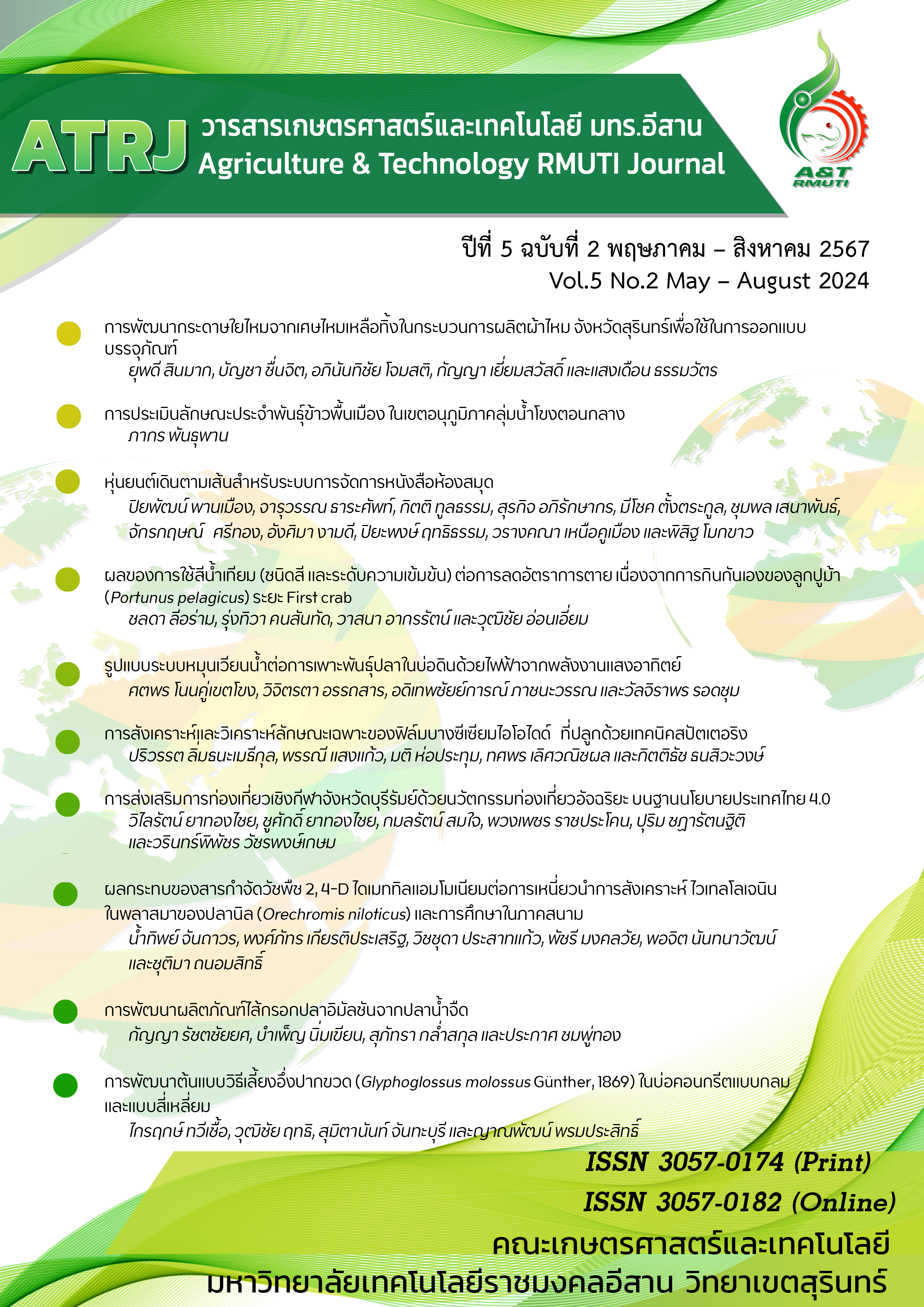การพัฒนาต้นแบบวิธีเลี้ยงอึ่งปากขวด (Glyphoglossus molossus Günther, 1869) ในบ่อคอนกรีตแบบกลมและแบบสี่เหลี่ยม
คำสำคัญ:
อึ่งปากขวด , การเจริญเติบโต , ลูกอึ่ง , การเลี้ยง , บ่อคอนกรีตบทคัดย่อ
อึ่งปากขวด (Glyphoglossus molossus Günther, 1869) เป็นสัตว์สะเทินน้ำสะเทินบกที่สำคัญชนิดหนึ่งของประเทศไทย โดยเฉพาะในภาคเหนือและภาคตะวันออกเฉียงเหนือ สัตว์ชนิดนี้ถูกจัดอยู่ในประเภทสัตว์เสี่ยงใกล้ถูกคุกคามโดย IUCN เนื่องจากถูกจับมาเป็นอาหารโดยคนในท้องถิ่นมากเกินไป การวิจัยครั้งนี้จึงมีวัตุประสงค์เพื่อศึกษาการเจริญเติบโตในระยะลูกอึ่งถึงอายุ 225 วัน เพื่อนำข้อมูลที่ได้ไปใช้เป็นต้นแบบในการพัฒนาเป็นสัตว์เศรษฐกิจ ทำการทดลองเลี้ยงในบ่อสภาพเลียนแบบธรรมชาติ 2 รูปแบบ ได้แก่ ในบ่อคอนกรีตแบบกลมและในบ่อคอนกรีตแบบสี่เหลี่ยม ผลการทดลองพบว่า การเลี้ยงในบ่อคอนกรีตแบบสี่เหลี่ยมให้ผลการเจริญเติบโตดีกว่าการเลี้ยงในบ่อคอนกรีตแบบกลมอย่างมีนัยสำคัญทางสถิติ (p<0.001) เมื่อเทียบกันแต่ละช่วงอายุ โดยมีน้ำหนักเฉลี่ยที่อายุ 45, 90, 135, 180 และ 225 วัน เท่ากับ 4.15, 10.84, 18.95, 23.66 และ 24.65 กรัม ตามลำดับ ในขณะที่การเลี้ยงบ่อคอนกรีตแบบกลม มีน้ำหนักเฉลี่ยเท่ากับ 0.64, 1.57, 2.70, 3.84 และ 5.04 กรัม ตามลำดับ โดยสรุป การเลี้ยงอึ่งปากขวดในบ่อคอนกรีตเลียนแบบสภาพธรรมชาติสามารถทำได้โดยใช้ปลวกเป็นอาหารหลัก โดยที่การเลี้ยงในบ่อคอนกรีตแบบสี่เหลี่ยมให้ผลการเจริญเติบโตที่ดีกว่า ขนาดพื้นที่ของบ่อและการจัดสภาพแวดล้อมในบ่อใกล้เคียงกับธรรมชาติมากที่สุดเป็นปัจจัยสำคัญที่ช่วยส่งเสริมการการเจริญเติบโตของอึ่งปากขวด
เอกสารอ้างอิง
กัลย์กนิต พิสมยรมย์ และสุวิมล ผดาศรี. (2563) ผลของแคลเซียมต่อการเจริญเติบโต และการลอกคราบของปูนา. วารสารวิทยาศาสตร์เกษตร. 51(1): 443-448.
ทองยุ่น ทองคลองไทร, วสันต์ ป้อมเสมา, วุฒิ รัตนวิชัย และชัยสงคราม ภูกิ่งเงิน. (2554). การพัฒนารูปแบบการเลี้ยงกบลูกผสมในบ่อซีเมนต์ กระชังและบ่อดิน. ใน การประชุมวิชาการมหาวิทยาลัยขอนแก่น ประจำปี 2554. เรื่องการพัฒนาอนาคตชนบทไทย: ฐานรากที่มั่นคงเพื่อการพัฒนาประเทศอย่างยั่งยืน 27-29 มกราคม 2554.มหาวิทยาลัยขอนแก่น. ขอนแก่น. 38-43.
ธเนศ นนท์ศรีราช (2562). ความหลากหลายทางพันธุกรรม โครงสร้างทางพันธุกรรม และความแปรผันทางสัณฐานวิทยาของอึ่ง ปากขวด (Glyphoglossus molossus) ในภาคตะวันออกเฉียงเหนือของประเทศไทย. วิทยานิพนธ์ปริญญาวิทยาศาสตรมหาบัณฑิต สาขาวิชาชีววิทยา มหาวิทยาลัยมหาสารคาม.
นฤชล ภัทราปัญญาวงศ์, วีรกิจ จรเกตุ และ ปิยะวัฒน์ พรหมรักษา (2562). ผลของการเลี้ยงขุนปูทะเล (Scylla spp.) เนื้อโพรกในบ่อซีเมนต์ และความน่าลงทุนในการเลี้ยงปูทะเลแบบพัฒนาในกล่องแยกเลี้ยงเดี่ยว. ใน การประชุมวิชาการระดับชาติ “วลัยลักษณ์วิจัย” ครั้งที่ 1. เรื่อง Smart Research and Innovation to Thailand 4.0 27-28 มีนาคม 2562. มหาวิทยาลัยวลัยลักษณ์. นครศรีธรรมราช. 1-7.
นิชาภา เฉตระการ, นันทิญา มณีโชติ, ชูจิต สาระภาค และอารีย์ ไกรสูรย์. (2564). ผลของอาหารที่ต่างกันต่อการเปลี่ยนแปลงทางกายภาพของบ่อเลี้ยงและการเจริญเติบโตของปลาไหลนา. วารสารวิทยาศาสตร์และเทคโนโลยี มหาวิทยาลัยมหาสารคาม. 40(4): 364-372.
พนมเทียน นาควิจิตร (2554). การเพาะพันธุ์อึ่งเพ้า. สำนักวิจัยและพัฒนาประมงน้ำจืด กรมประมง. เอกสารวิชาการฉบับที่ 36/2554: 1-27.
เมฆ มากล้น, กฤติมา กษมาวุฒิ และสำเนาว์ เสาวกูล. (2564). ชนิดของอาหารที่เหมาะสมเพื่อลดต้นทุนต่อการเลี้ยงปลาดุกยักษ์ในกระชังบก. วารสารเกษตรศาสตร์และเทคโนโลยี. 2(1): 37-49.
วัชรีพร เลื่อมใส และสุนทร นาดี (2564) คู่มือการเลี้ยงจิ้งหรีดฉบับประชาชน. (2564). ค้นเมื่อ 10 เมษายน 2565. https://region6.dld.go.th/webnew/images/Z016.pdf.
สิริฉัตร สุนทรวิภาต, พงษ์พันธ์ สุนทรวิภาต, อภิชาต เต็มวิชชาการ และประจวบ สายบุ. (2555). การเพาะและอนุบาลอึ่งปากขวด. วารสารวิจัยเทคโนโลยีการประมง. 6(2): 12-22.
Akullo J., Agea J.G., Obaa B.B., Okwee-Acai J. and Nakimbugwe D. (2018). Nutrient composition of commonly consumed edible insects in the Lango sub-region of northern Uganda. International Food Research Journal. 25(1): 159-165.
Altig R. and Rowley J.L.L. (2014). The breeding behavior of Glyphoglossus molossus and the tadpoles of Glyphoglossus molossus and Calluella guttulata (Microhylidae). Zootaxa. 3811(3): 381-386.
Atowa C.O., Okoro B.C., Umegoc E.C., Atowa A.O., Emmanuel O., Udee V.C. and Ugbogu E.A. (2021). Nutritional values of Zonocerus variegatus, Macrotermes bellicosus and Cirina forda insects: Mineral composition, fatty acids and amino acid profiles. Scientific African. 12: 1-10.
Behr N. and Rödder D. (2018). Larval development stages and husbandry of the Rice Frog Microhyla mukhlesuri Hasan et al., 2014 (Anura: Microhylidae). Bonn zoological Bulletin. 67(2): 109-116.
Day T. and Rowe L. (2002). Developmental thresholds and the evolution of reaction norms for age and size at life-history transitions. American Naturalist. 159(4): 338-350.
Deori N., Saikia R. and Gogoi R. (2019). Termites as protein source for economic production of Japanese quail. International Journal of Current Microbiology and Applied Sciences. 8(6): 1886-1891.
Diaz L.M., Inchaustegui S.J. and Marte C. (2014). Preliminary experiences with the husbandry, captive breeding, and development of the hispaniolan yellow tree frog, Osteopilus pulchrilineatus (Amphibia: Anura: Hylidae), with Ecological and ethological notes from the wild. Herpetological Review. 45(1): 52–59.
Galunder K. and Rödder D. (2018). Developmental ecology and larval staging in Polypedates otilophus (Boulenger, 1893) (Anura: Rhacophoridae). Bonn zoological Bulletin. 67 (2): 117-128.
IUCN Red List of Threatened Species. (2023). The IUCN red list of threatened speciesTM. Accessed 19 Mar. 2023. https://www.iucnredlist.org/search?query=Glyphoglossus%20molossus%20&searchType=species.
Laghari M.Y., Dars B.A. and Narejo N.T. (2011). Length-weight relationship of Tilapia niloticus in concrete pond of Habib ADM, Hub, Balochistan. Sindh University Research Journal (Science Series). 43(1): 29-32.
Laojumpon C., Suteethorn S. and Lauprasert K. (2012). Morphological variation of truncate-snouted burrowing frog (Glyphoglossus molossus) of Thailand. In The 4th Science Research Conference. 12-13 March 2012. Faculty of Science, Naresuan University. Phitsanulok.
Mansano C.F.M, Macente B.I., Khan K.U., do Nascimento T.M.T., da Silva E.P., Sakomura N.K. and Fernandes J.B.K. (2017). Morphometric growth characteristics and body composition of fish and amphibians. In: Pares-Casanova PM, ed. New Insights into Morphometry Studies. London: InTech. 7-28.
Michaels C.J. and Försäter K. (2017). Captive breeding of Pelophylax water frogs under controlled conditions indoors. The Herpetological Bulletin. 142: 29-34.
Narayan E., Christi K. and Morley C. (2009). Captive propagation of the endangered native Fijian frog Platymantis vitiana: Implications for ex-situ conservation and management. Pacific Conservation Biology. 15: 47-55.
Nonsrirach T. and Lauprasert K. (2019). Preliminary report on the genetic structure of Glyphoglossus molossus (Anura: Microhylidae) from the Khorat Plateau, north-eastern Thailand. Journal of Natural History. 53: 849-861.
Oti E.E. and Nwani C.D. (2007). Comparative studies on the growth and survival of African catfish, Clarias gariepinus (Burchell, 1822) juveniles reared in cages suspended in concrete tank and earthen pond in Umudike, Abia State. Bio-Research. 5(1): 210-215.
Plessis L.D., Armstrong A., Malepa P.L., Kanengoni A.T., Price C. and Downs C.T. (2022). Developmental life stages of the Pickersgill's reed frog (Hyperolius pickersgilli) in an ex-situ environment at Johannesburg Zoo's captive breeding facility, South Africa. Zoo Biology. 41:533-543.
Redbond J., Lamont H., Boor F. and Tyrrell M. (2019). Captive husbandry and breeding of the reticulated glass frog, Hyalinobatrachium valerioi (Anura: Centrolenidae). The Herpetological Bulletin. 150: 14-17.
Serrano A.E. and Poku G.J. (2014). Nutritive value of termite as fish meal supplement in the diet of freshwater prawns (Macrobrachium rosenbergii de Man) juveniles. ELBA Bioflux. 6(2): 63-71.
Siulapwa N., Mwambungu A., Lungu E. and Sichilima W. (2012). Nutritional value of four common edible insects in Zambia. International. Journal of Science and Research (IJSR). 3(6): 876-884.
Sretarugsa P., Luangborisut P., Kruatrachue M. and Upatham S. (1997). Effects of diets with various protein concentrations on growth, survival and metamorphosis of Rana tigerina and R. catesbeiana. Journal of the Science Society of Thailand. 23: 209-224.
Stiles R.M., Sieggreen M.J., Johnson R.A., Pratt K., Vassallo M., Andrus M., Perry M., Swan J.W. and Lannoo M.J. (2016). Captive-rearing state endangered crawfish frogs Lithobates areolatus from Indiana, USA. Conservation Evidence. 13: 7-11.
Tong Q., Du X.P., Hu Z.F., Cui L.Y. and Wang H.B. (2018). Modelling the growth of the brown frog (Rana dybowskii). PeerJ-Life & Environment: Zoological Science. 1-21.
ดาวน์โหลด
เผยแพร่แล้ว
รูปแบบการอ้างอิง
ฉบับ
ประเภทบทความ
สัญญาอนุญาต
ลิขสิทธิ์ (c) 2024 วารสารเกษตรศาสตร์และเทคโนโลยี

อนุญาตภายใต้เงื่อนไข Creative Commons Attribution-NonCommercial-NoDerivatives 4.0 International License.
เนื้อหาและข้อมูลในบทความที่ลงตีพิมพ์ในวารสารทดสอบระบบ ThaiJo2 ถือเป็นข้อคิดเห็นและความรับผิดชอบของผู้เขียนบทความโดยตรงซึ่งกองบรรณาธิการวารสาร ไม่จำเป็นต้องเห็นด้วย หรือร่วมรับผิดชอบใดๆ
บทความ ข้อมูล เนื่อหา รูปภาพ ฯลฯ ที่ได้รับการดีพิมพ์ในวารสารทดสอบระบบ ThaiJo2 ถือเป็นลิขสิทธิ์ของวารสารทดสอบระบบ ThaiJo2 หากบุคคลหรือหน่วยงานใดต้องการนำทั้งหมดหรือส่วนหนึ่งส่วนใดไปเผยแพร่หรือเพื่อกระทำการใดๆ จะต้องได้รับอนุญาตเป็นลายลักอักษรณ์จากวารสารทดสอบระบบ ThaiJo2 ก่อนเท่านั้น







